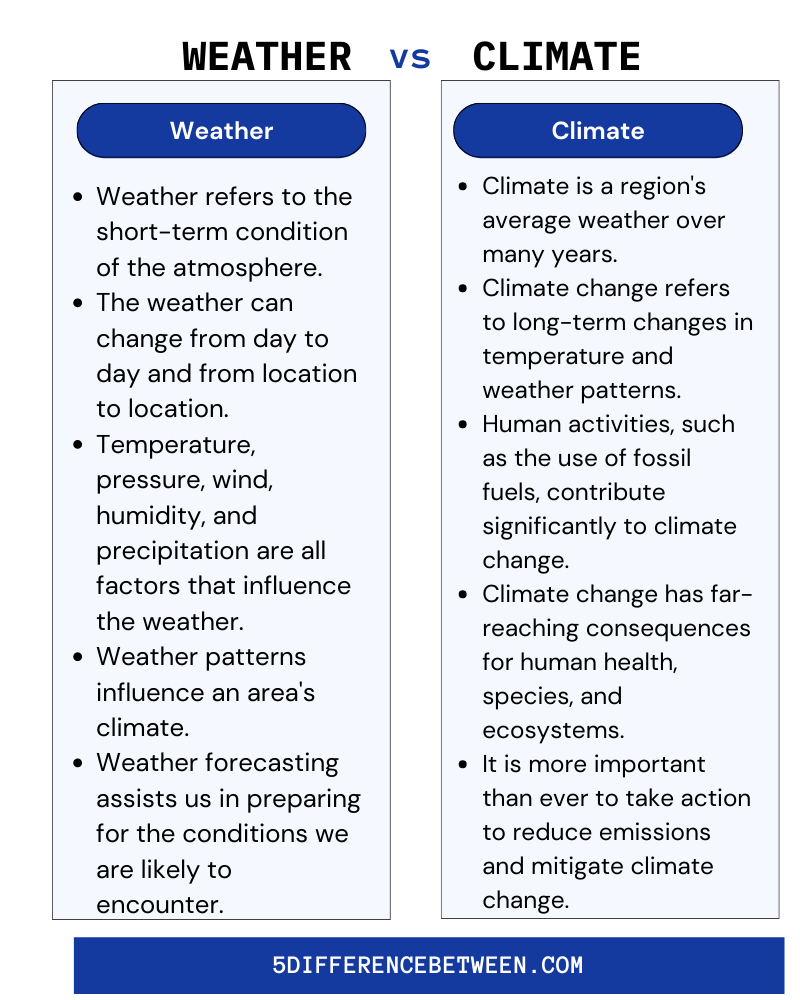While the atmospheric energies with time and human interference are getting affected each day, it is essential to understand the difference between weather and climate which are both terms used to describe atmospheric conditions. The difference between weather and climate is that the state of the atmosphere at a specific location and time is referred to as weather, whereas climate refers to the average weather of a specific region over time. Although they are related, they are not the same and differ significantly.
What is Weather?
Weather is the state of the atmosphere in a specific location at a given time. Temperature, precipitation, humidity, wind speed and direction, air pressure, and cloud cover are all components. Weather is highly variable and rapidly changing, but it also exhibits patterns and trends that can be observed over time. Weather is the result of many factors, including the sun’s energy, the temperature of the ocean, and the composition of the atmosphere.
The sun’s energy powers the weather system by supplying the heat energy required to power the water cycle and cause air to rise and fall. The temperature of the ocean influences the amount of moisture in the air, which influences precipitation. The composition of the atmosphere influences how clouds form, how temperatures vary, and how storms develop.
Also Read > Difference Between Leader and Manager
Weather has a large influence on people’s lives, influencing agriculture, transportation, and energy consumption. It also has an impact on a region’s climate by contributing to long-term temperature and precipitation patterns. Meteorologists study weather by using various tools such as satellites and radar to measure and predict weather conditions. Weather plays an important role in many aspects of life, from daily planning to long-term decisions. People can stay informed and prepared for whatever the weather throws at them if they understand the fundamental elements of weather.
What is Climate?
The climate of a region is the long-term average of weather patterns and phenomena. It is determined by the average temperature, precipitation, wind, and other environmental variables in the region. Climate is a broad concept that includes physical, chemical, and biological aspects of the atmosphere. Several factors influence climate, including latitude, elevation, ocean currents, mountain ranges, landforms, and vegetation.
The primary driver of climate is solar radiation, which is the amount of sunlight received at the Earth’s surface. It is in charge of the various temperatures and moisture levels in the atmosphere. Climate forcings, or external factors that drive climate change, also have an impact on climate. Changes in volcanic activity, solar radiation, and greenhouse gas emissions are examples of natural and anthropogenic forcings.
Climate change can be caused by natural phenomena such as El Nio and La Nia events, as well as human activities such as the use of fossil fuels and deforestation. These activities have the potential to raise global temperatures, reduce snow and ice cover, and alter precipitation patterns. It has a significant impact on human and environmental health and well-being. It has an impact on all aspects of life, from the food and water we consume to the ecosystems on which we rely. As a result, it is critical to monitor and comprehend climate change in order to safeguard our planet for future generations.
Weather Vs Climate

Effects of Weather and Climate change
Weather and climate change can have serious consequences for the environment. Temperature, precipitation, and wind all have an impact on ecosystems and the species that inhabit them. Increased temperatures can cause more evaporation, resulting in more frequent and severe droughts and floods. The health of sensitive species, such as those adapted to cold climates, may also be jeopardized by rising temperatures. Climate change can also cause sea level rise, which can cause coastal flooding and habitat destruction. Finally, the effects of weather and climate change are felt all over the world, and they can have serious consequences for the environment and its inhabitants.
Conclusion
To summarize, climate Vs weather definition are unique yet they both are two distinct but frequently confused concepts. The daily variations in temperature, precipitation, humidity, wind, and other atmospheric conditions in a specific location are referred to as weather. It is constantly changing and is influenced by short-term events like the passage of a cold front. In contrast, climate is the long-term average of weather conditions. It includes the average temperature, precipitation, and other characteristics of a particular area over a long period of time, typically 30 years or more.

One Comment to “5 Difference Between Weather and Climate”